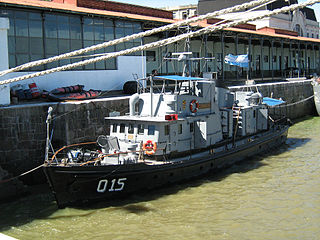
Port Belgrano Naval Base is the largest naval base of the Argentine Navy, situated next to Punta Alta, near Bahía Blanca, about 560 km (348 mi) south of Buenos Aires. It is named after the brigantine General Belgrano which sounded the area in late 1824.

ARA Buenos Aires was the lead ship of her class of destroyer built for the Argentine Navy, in service from 1938 to 1971.

The corbeta (corvette) ARA Uruguay, built in England, is the largest ship afloat of its age in the Armada de la República Argentina, with more than 140 years passed since its commissioning in September 1874. The last of the legendary squadron of President Sarmiento, the Uruguay took part in revolutions, ransoms, expeditions, rescues, and was even floating headquarters of the Navy School. During its operational history 1874–1926 the Uruguay has served as a gunboat, school ship, expedition support ship, Antarctic rescue ship, fisheries base supply ship, and hydrographic survey vessel, and is now a museum ship in Buenos Aires. This ship may be the oldest in South America having been built in 1874 at Laird Bros. shipyard of Birkenhead, England, at a cost of £32,000. This ship is rigged to a barque sailplan. The ship's steel hull is sheathed in teak.

ARA King is a World War II-era Argentine Navy warship, originally classified as minelayer and later as patrol ship. The vessel is named after Juan King, an Argentine naval officer that served in the Cisplatine War. It is the third Argentine naval ship with this name.

ARA Azopardo is a World War II era Argentine Navy warship, originally classified as patrol boat and later as antisubmarine frigate. The vessel is named after Juan Bautista Azopardo, an Argentine naval officer that served in both the Argentine War of Independence and in the Cisplatine War. It is the third Argentine naval ship with this name.

ARA Cormorán (Q-15) is a hydrographic survey boat of the Argentine Navy, built in the Río Santiago Shipyard and based in Buenos Aires. The vessel is named after the cormorant, a seabird that inhabits Argentina’s littoral, and is the fourth Argentine naval ship with this name.
ARA Petrel was a hydrographic survey boat of the Argentine Navy, built in the Cadenazzi Shipyard and based in Buenos Aires. The vessel is named after the petrel, a seabird that inhabits Argentina's littoral, and is the third Argentine naval ship with this name.

ARA Zurubí (P-55) is a patrol boat of the Argentine Navy, built in the Río Santiago Shipyard in 1938 and based in Ushuaia. The vessel is named after the Surubí, a catfish that inhabits Argentina’s Mesopotamia, and is the first Argentine naval ship with this name.
ARA Azopardo was a steam transport of the Argentine Navy, built in the Stabilimento Tecnico Triestino and sold to Argentina in 1884. It was based, among others, in the port of Buenos Aires and later Ushuaia, and was decommissioned in 1922 after being sunk in an accident; it was refloated and sunk in 1924 as a target. The vessel was named after the Juan Bautista Azopardo, a Maltese privateer and officer of the Argentine Navy during the Independence and Cisplatine wars, and was the first Argentine naval ship with this name.

The Murature-class patrol ships are a class of World War II era Argentine Navy warships, originally classified as minelayers and later reclassified as patrol ships. The class is named after José Luis Murature, Foreign Minister of Argentina from 1916 to 1918.

ARA Cabo de Hornos (B-5) was a cargo ship in service with the Argentine Navy since 1979, capable of transporting bulk cargo, live cattle, and containers. She was the second ship in the Argentine Navy to bear the name of the Cape Horn (Chile) located to the south of Tierra del Fuego.

ARA Canal Beagle (B-3) is a cargo ship in service with the Argentine Navy since 1978, capable of transporting bulk cargo, live cattle, and containers. She is the second ship in the Argentine Navy to bear the name of the Beagle Channel in the south of Tierra del Fuego.

The Costa Sur-class cargo ship is a class of three cargo ships designed and built in Argentina in 1975–1979 for servicing the Patagonic coast routes; capable of transporting bulk cargo, live cattle, and containers. The ships have been in service with the Argentine Navy since 1978. The class is named after the southern coastal area of Argentina which was designed to service.
ARA Ingeniero Julio Krause (B-13) was an oil tanker ship in service with the Argentine Navy from 1993 to 2015, and with YPF from to 1981 to 1993. She was the first ship in the Argentine Navy to bear the name of Argentine engineer Julio Krause, who discovered oil in Comodoro Rivadavia in 1907.

ARA Punta Alta (Q-63) is a multipurpose auxiliary ship of the Argentine Navy, built in the Curtis Bay Shipyard, United States, in 1964; transferred to Argentina in 2000, she is based at Puerto Belgrano. The vessel is named after the Argentine city of Punta Alta, which is close to Puerto Belgrano, and is the second Argentine naval ship with this name.
ARA Punta Médanos (B-18) was an auxiliary ship of the Argentine Navy, a tanker built at the Swan, Hunter & Wigham Richardson shipyard, Wallsend, in 1950. While in naval service she made several commercial trips supplementing the YPF tanker fleet, and supported the high seas fleet; in this capacity Punta Médanos participated in the Falklands War in 1982. She was decommissioned in 1984 and sold for scrapping. The vessel was named after the coastal feature of Punta Médanos, Argentina, and was the first Argentine naval ship with this name.
ARA Luisito (Q-51) is a training ship of the Argentine Navy, in service since 1985 and based in Mar del Plata; where she is used to train students from Argentina’s National Fishing School. The vessel is the first Argentine naval ship with this name.













